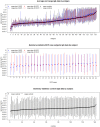Retrospective Identification of a Broad IgG Repertoire Differentiating Patients With S. aureus Skin and Soft Tissue Infections From Controls
- PMID: 30792711
- PMCID: PMC6375365
- DOI: 10.3389/fimmu.2019.00114
Retrospective Identification of a Broad IgG Repertoire Differentiating Patients With S. aureus Skin and Soft Tissue Infections From Controls
Abstract
Background: Although the relevance of humoral immunity for protection against S. aureus skin and soft tissue infections (SSTIs) has been suggested by several animal and human studies, the question of which human antibodies may be protective has so far impeded the development of a safe and effective vaccine. Because most adults have developed certain anti-S. aureus antibodies due to S. aureus colonization or infection, we hypothesized that the titers of antibodies to S. aureus in uninfected controls would differ from those in infected patients and would also differ in infected patients from the time of acute infection to a 40-day convalescent serum. Methods: To test these hypotheses, we measured human antibody levels against a panel of 134 unique antigens comprising the S. aureus surfome and secretome in subjects with active culture-confirmed S. aureus SSTIs (cases) and in controls with no infection, using a novel S. aureus protein microarray. Results: Most S. aureus SSTI patients (n = 60) and controls (n = 142) had antibodies to many of the tested S. aureus antigens. Univariate analysis showed statistically weak differences in the IgG levels to some antigens in the SSTI patient (case) sera compared with controls. Antibody levels to most tested antigens did not increase comparing acute with 40-day serum. Multiple logistic regression identified a rich subset of antigens that, by their antibody levels, together correctly differentiated all cases from all controls. Conclusions: Antibodies directed against S. aureus antigens were present both in patients with S. aureus SSTIs and in uninfected control patients. We found that SSTI patients and controls could be distinguished only based on differences in antibody levels to many staphylococcal surface and secreted antigens. Our results demonstrate that in the studied population, the levels of anti-S. aureus antibodies appear largely fixed, suggesting that there may be some level of unresponsiveness to natural infection.
Keywords: Staphylococcus aureus; antibodies; antibody response; microarray; skin infection.
Figures






Similar articles
-
Human Memory B Cells Targeting Staphylococcus aureus Exotoxins Are Prevalent with Skin and Soft Tissue Infection.mBio. 2018 Mar 13;9(2):e02125-17. doi: 10.1128/mBio.02125-17. mBio. 2018. PMID: 29535203 Free PMC article.
-
A Diagnostic Serum Antibody Test for Patients With Staphylococcus aureus Osteomyelitis.Clin Orthop Relat Res. 2015 Sep;473(9):2735-49. doi: 10.1007/s11999-015-4354-2. Epub 2015 May 27. Clin Orthop Relat Res. 2015. PMID: 26013151 Free PMC article.
-
Characterization of the humoral immune response during Staphylococcus aureus bacteremia and global gene expression by Staphylococcus aureus in human blood.PLoS One. 2013;8(1):e53391. doi: 10.1371/journal.pone.0053391. Epub 2013 Jan 7. PLoS One. 2013. PMID: 23308212 Free PMC article.
-
Prevalence of IgG and Neutralizing Antibodies against Staphylococcus aureus Alpha-Toxin in Healthy Human Subjects and Diverse Patient Populations.Infect Immun. 2018 Feb 20;86(3):e00671-17. doi: 10.1128/IAI.00671-17. Print 2018 Mar. Infect Immun. 2018. PMID: 29263109 Free PMC article.
-
Proteomic Identification of saeRS-Dependent Targets Critical for Protective Humoral Immunity against Staphylococcus aureus Skin Infection.Infect Immun. 2015 Sep;83(9):3712-21. doi: 10.1128/IAI.00667-15. Epub 2015 Jul 13. Infect Immun. 2015. PMID: 26169277 Free PMC article.
Cited by
-
Impaired T-Lymphocyte Responses During Childhood Staphylococcus aureus Infection.J Infect Dis. 2022 Jan 5;225(1):177-185. doi: 10.1093/infdis/jiab326. J Infect Dis. 2022. PMID: 34145461 Free PMC article.
-
A Comprehensive View on the Human Antibody Repertoire Against Staphylococcus aureus Antigens in the General Population.Front Immunol. 2021 Mar 10;12:651619. doi: 10.3389/fimmu.2021.651619. eCollection 2021. Front Immunol. 2021. PMID: 33777051 Free PMC article.
-
Toxin-neutralizing Abs are associated with improved T cell function following recovery from Staphylococcus aureus infection.JCI Insight. 2024 Jan 18;9(4):e173526. doi: 10.1172/jci.insight.173526. JCI Insight. 2024. PMID: 38236641 Free PMC article.
-
Staphylococcus aureus Vaccine Research and Development: The Past, Present and Future, Including Novel Therapeutic Strategies.Front Immunol. 2021 Jul 7;12:705360. doi: 10.3389/fimmu.2021.705360. eCollection 2021. Front Immunol. 2021. PMID: 34305945 Free PMC article. Review.
-
Dissecting the Human Response to Staphylococcus aureus Systemic Infections.Front Immunol. 2021 Nov 8;12:749432. doi: 10.3389/fimmu.2021.749432. eCollection 2021. Front Immunol. 2021. PMID: 34819932 Free PMC article.
References
Publication types
MeSH terms
Substances
Grants and funding
LinkOut - more resources
Full Text Sources
Medical
Molecular Biology Databases

